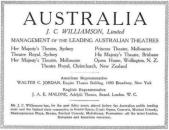Revue.
Australia's first-ever revue, Come Over Here was adapted for local audiences by Frank Dix and his production from the original by British writer Max Pemberton and American writer W. Mizner, with the intent being to present a satirical and topical entertainment spectacular based on the popular culture theatre trend currently finding appeal in America, Britain and Europe, but which had social relevance to Australians. The Sydney Morning Herald notes in this regard : '[The] elements of gaiety form the dominating constituents of Come Over Here. This Parisian manner of glancing at the current events of life's passing show, now first brought forward in Australia by the J. C. WilliamsonJ. C. Williamson direction, closely resembles a variety entertainment which becomes less account than the magnificence of its background. Remodelled to local conditions by Mr Frank Dix, the revue was practically a new piece' (22 December 1913, p3).
Further localisation was also specifically incorporated into the Sydney and Melbourne seasons. The Sydney season, for example, saw scenic artist W. Little illustrate a number of local settings (set variously in the past, present and future), including: 'The Farmers' Roof Garden' (with glimpses of Her Majesty's Theatre, St Mary's Cathedral and other familiar objects); 'A Venetian Fete at Manly in 1999'; 'The Aboriginals" (which presented a view of Circular Quay in its virgin state in 1700); 'The First Settlers' (1801); 'The Gold Rush' (1849); and the vestibule of the Hotel Australia, followed by a view of the Winter Garden, looking stately in festival array. For the 1914 Melbourne production some of these scenes were changed to incorporate Victorian settings. One notable change was the 'Venetian Fete', which became 'Henley-on-Yarra' in 1999. A scene from Flemington ('Under the Elms') was also presented, with performers impersonating well-known figures from the state. Other local settings were : scenes of Collins Street (in 1830, 1857 and 1914) ; the Melbourne Exhibition of 1880; 'The Birth of Melbourne' (set to music especially composed by Andrew MacCunn), Yarra Bend Station and Kosciusko (Argus 30 March 1914, p.13).
While the revue's objective was to target high profile Australian personalities, the Sydney debut found itself heavily criticised for being out of date. Hits at former Prime Minister George Reid (1904-05) were presented as examples of this. In one prominent scene, too, ex-NSW premiers C. G. Wade (1907-10) and the recently deposed James McGowan (1910-1913), impersonated by Fred Leslie and Jack Cannot respectively, waged a heated dispute following a motor car accident. The Bulletin also took a swipe at those responsible, proposing that they seemed to be under the delusion that McGowan was still Premier. The Sydney Morning Herald notes, however, that the same scene had some merit. 'Little Australia, a part cleverly played by Gertrude Cremar', writes the paper's critic, 'slipped in between the disputants and exclaimed, "When you've done calling each other names, perhaps you'll do something for me!" This was one of the most appreciated points in the dialogue, newly localised and brought up to date by Mr Dix'. Stung by the criticism Dix quickly introduced more topical matter. By the time the production premiered in Melbourne hits at the current Prime Minister and leader of the opposition were being featured.
A good deal of ragtime music was introduced into the revue, in addition to arias from recent operas and music to accompany current dance crazes like the Tango. Specialist dancers Fred Leslie and Ivy Shilling also staged their 'movement spectacular' called 'The Spider's Web.' This act saw Shilling (representing a butterfly) trapped in a 'colossal circle of gossamer threads' while Leslie, as the arachnid, circled menacingly (in later years the same act was reinterpreted in Australia by such performers as contortionist Hector 'The Human Spider' Napier and dancer Robert Helpmann). Among the revue's biggest musical hits were the songs performed by comedians Daisy Jerome and Jack Cannot. Jerome's specialties included: 'The Press, the Pulpit and the Petticoat', 'Smart, Smart, Smart', 'Do they all go out to see the Sea', 'Popsy was a Singer,' 'Daisy Dip' and 'Row, Row, Row.' Cannot, who 'seemed to be on the stage all evening' found much success with 'That German Band'. Other songs incorporated into the production included: 'Wedding Glide,' 'My Sumurun Girl,' 'Come Josephine in My Flying Machine' and 'Take Me in Your Arms' (Olive Godwin and Charles Stone); 'On the Missouri' (Edith Boulton and chorus); 'Love's Rose' (Edmund Sherras); 'That Minstrel Show' (Charles Stone), 'Dear Little Muff' (Winnie Volt) and Gertie Cremer's 'Little Australia' (ctd. in 'Love's Rose' by Tom Armstrong).
NB: Unless otherwise cited all quotations are from the Sydney Morning Herald 22 December 1913, p.3.

